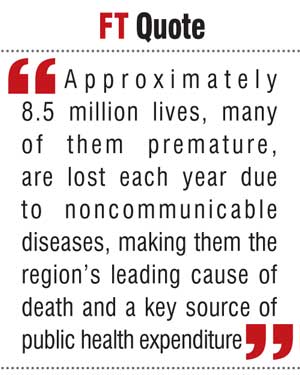Thursday Jan 01, 2026
Thursday Jan 01, 2026
Friday, 2 September 2016 00:01 - - {{hitsCtrl.values.hits}}
 Noncommunicable diseases such as diabetes, respiratory diseases, cancer and heart diseases are taking a severe toll on public health across the WHO South-East Asia Region. Approximately 8.5 million lives, many of them premature, are lost each year due to noncommunicable diseases (NCDs), making them the region’s leading cause of death and a key source of public health expenditure.
Noncommunicable diseases such as diabetes, respiratory diseases, cancer and heart diseases are taking a severe toll on public health across the WHO South-East Asia Region. Approximately 8.5 million lives, many of them premature, are lost each year due to noncommunicable diseases (NCDs), making them the region’s leading cause of death and a key source of public health expenditure.
With the NCD burden expected to rise in coming years, due largely to the region’s rapid development and associated lifestyle changes, countries have taken steps to arrest the problem: multisectoral plans are being developed; health promotion campaigns are being carried out; exposure to NCD risk factors such as alcohol and tobacco are being curtailed; and NCD monitoring has been enhanced. But as countries strive to make a one-third reduction in premature deaths caused by NCDs by 2030, there is an important tool that remains underutilised: the primary healthcare system.
By bringing NCD care to the primary healthcare level, health authorities have the opportunity to ensure appropriate services are provided to the right people, at the right place and at the right time. While policies aimed at providing high-tech care at central hospitals can have results, their impact will always be limited and will almost always be reactive. Primary health facilities are not only better equipped to provide the holistic, patient-centred focus that preventing and managing an NCD requires, but they can also enhance equity and access to NCD care – an aim central to the Sustainable Development Goals.
There are several steps that health authorities can take to bring NCD care directly to the people and to roll-back their tragic and costly burden.
First, national health and development policies must be recalibrated. This means putting the primary health approach front and centre of national NCD action plans, as well as drafting and implementing a range of supporting protocols, from clear policies outlining the spectrum of primary level NCD services to well-defined diagnostic and treatment guidelines. This will enhance the health system’s structural coherency, and will also allow patients and health workers to better navigate it.
Second, healthcare workers at the primary level must be given the knowledge and skills to provide NCD and associated risk factor care. This means providing comprehensive training for frontline health workers in NCD screening and management strategies as well as enabling them to provide effective advice on NCD prevention, including healthy lifestyle messages. A team-based approach that harnesses a range of skillsets is required, and may include developing additional cadres of health counsellors or social workers.
 Third, the availability of generic essential medicines and basic technologies for NCD management must be guaranteed at the primary level. To do so, procurement policies must be reviewed and essential medicine lists updated. Every person suffering from diabetes, for example, must be able to access a blood glucose meter at their local healthcare provider, just as all persons suffering from a respiratory disease should be able to access the technologies and medicines that ensure they can breathe easy.
Third, the availability of generic essential medicines and basic technologies for NCD management must be guaranteed at the primary level. To do so, procurement policies must be reviewed and essential medicine lists updated. Every person suffering from diabetes, for example, must be able to access a blood glucose meter at their local healthcare provider, just as all persons suffering from a respiratory disease should be able to access the technologies and medicines that ensure they can breathe easy.
Finally, health authorities must put in place funding mechanisms to facilitate primary level NCD care. While shifting NCD care to the primary level will reduce health system expenditures overall (not to mention out-of-pocket costs borne by patients), making this possible nonetheless requires effective budget allocations and robust planning. At the same time, increased taxation of health-damaging commodities such as tobacco, alcohol and unhealthy foods and beverages should be considered, both as a means to diminish demand for these products as well as to increase revenue for NCD prevention and control.
Importantly, the shift to a primary health approach to NCD care must occur alongside efforts to achieve universal health coverage. Primary health facilities are crucial to the goal of ensuring all people everywhere get the care they need without facing financial hardship, meaning gains in coverage will accelerate efforts to reverse the NCD burden. The pursuit of universal health coverage must be seen as an essential component of the wider campaign to tackle NCDs effectively.
To be sure, preventing and managing NCDs is one of the greatest challenges health authorities across the region face. The NCD burden is already causing significant social and economic costs, with any increases certain to exacerbate negative outcomes and further stymie development. In turning the situation around and meeting global and regional NCD targets, shifting screening and management of diabetes, heart diseases, cancers and respiratory diseases to the primary level is of vital importance. A healthier, more prosperous South-East Asia region will be the result.
(The writer is Regional Director, World Health Organization South-East Asia Region.)